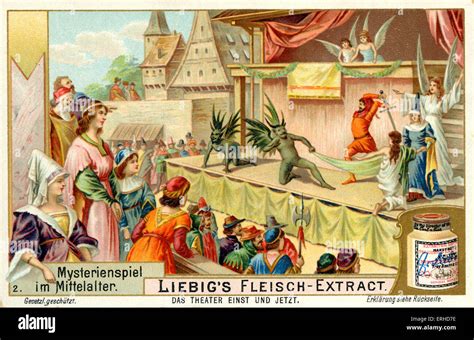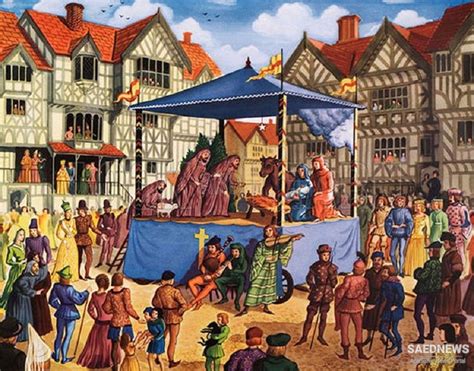medieval theatre and tudor | history of medieval theatre medieval theatre and tudor Elizabethan Theatre, sometimes called English Renaissance theatre, refers to that style of performance plays which blossomed during the . Find all Air Malta flights, destinations, routes and airports on this interactive airline map. See the most popular routes, departure and arrival airports, and timetables .
0 · middle ages theatre
1 · medieval theatre plays
2 · medieval theatre pdf
3 · medieval theatre genres
4 · medieval theater wikipedia
5 · medieval theater themes
6 · medieval theater examples
7 · history of medieval theatre
Buy A.J. Morgan Castro Round Sunglasses, Amber, 49 mm and other Sunglasses at Amazon.com. Our wide selection is eligible for free shipping and free returns.
middle ages theatre
Interlude, in theatre, early form of English dramatic entertainment, sometimes considered to be the transition between medieval morality plays and Tudor dramas. Interludes were performed . Balancing the interests and concerns of scholars in theatre history, drama, and literary studies, its scope reflects the broad reach of Tudor drama as a subject, inviting readers .
Elizabethan Theatre, sometimes called English Renaissance theatre, refers to that style of performance plays which blossomed during the .
gucci bag $1000
The Cambridge Companion to Medieval English Theatre, second edition, continues to provide an author-itative introduction and an up-to-date, illustrated guide to the mystery cycles, morality .Renaissance English Drama: From Medieval to Renaissance. By Anniina Jokinen, Luminarium. English Renaissance drama grew out of the established Medieval tradition of the mystery and . The growth of theatres in Tudor England, and especially in the reign of Elizabeth, is very much associated with this era. Along with sports and pastimes, theatres provided the .English historians struggle harder to make ‘sixteenth-century drama’ work as a narrative frame and usually opt for ‘Tudor drama’, since the Tudor dynasty ruled from 1485–1603.
Elizabethan drama. Altogether, the editors wisely refuse to divide the Tudor era into medieval and Renaissance sections; rather they embrace Pincombe and Shrank's sweeping view of the . Elizabethan Theatre, sometimes called English Renaissance theatre, refers to that style of performance plays which blossomed during the reign of Elizabeth I of England (r. 1558-1603) and which continued under her .
Masks and Masking in Medieval and Early Tudor England presents a broad overview of masking practices, demonstrating how active and prominent an element of medieval and pre-modern culture masking was. . theatre and anthropology. Through its analysis of masked play this study engages both with the history of theatre and performance, and with . In Medieval Theatre Performance, edited by Phillip Butterworth and Katie Normington, 15–34. Cambridge: D. S. Brewer, 2017. . Theatre 5 (1983): 123–180. Google Scholar Twycross, Meg, and Sarah Carpenter. Masks and Masking in Medieval and Early Tudor England. Aldershot: Ashgate, 2002. Google Scholar Walker Bynum, Caroline. ‘The Body of .
The medieval Mystery Cycles, with their vibrant presentation of scriptural narrative, dominate discussion of medieval drama. Together with the Morality Plays, which do not tell scriptural stories but which consider the human soul as it falls into sin and is then redeemed, and the Saints' Plays, which stage a similar narrative in the life of a named saint, the cycles contribute to a picture of . Newest research into drama and performance of the Middle Ages and Tudor period. Medieval English Theatre is the premier journal in early theatre studies. Its name belies its wide range of interest: it publishes articles on theatre and pageantry from across the British Isles up to the opening of the London playhouses and the suppression of the civic religious plays, .The allegorical drama written in England during the fifteenth and sixteenth centuries is one of literary history’s most static genres. Though performed decades apart, plays like The Castle of Perseverance (c. 1400–25), Mankind (c. 1450), Magnyfycence (c. 1519) and Wyt and Science (c. 1531–47) tell similar stories of temptation, fall and regeneration.During the Tudor period, all the actors on the Globe Theatre stage were male. Female roles were played by young male actors, as women were not allowed to perform on stage until the Restoration era. The end of the medieval period and the beginning of the Tudor period are marked by the Battle of Bosworth in 1485 when Henry Tudor (Henry VII .
Medieval English Theatre is a society which exists to promote interest in and study of early theatre both within and beyond the academic community. Since 1979 it has published an international refereed journal, Medieval English Theatre , now one of the leading publications on medieval and Tudor theatre up to the rise of the commercial .Medieval English Theatre is the premier journal in early theatre studies. Its name belies its wide range of interest: it publishes articles on theatre and pageantry from across the British Isles up to the opening of the London playhouses and the suppression of the civic mystery cycles, and also includes contributions on European and Latin drama, together with analyses of modern .
‘Masks’ to the second annual Medieval English Theatre meeting, which was discussing ‘Props and Costumes’. This was published in Medieval English Theatre 3 and 4, and we then started expanding it into a book. Some time later we realised that we were researching the entire history of medieval theatre, festivity, pageantry, and folk custom.
Medieval theater emerged from the religious practices and traditions of the Middle Ages, gradually evolving from simple liturgical ceremonies into more elaborate dramatic performances; . John Heywood's The Four Ps and Johan Johan are notable examples of Tudor interludes; Minstrels, troubadours and jongleurs.
Learn about medieval theatre, from medieval liturgical drama to farce. Explore the medieval stage, medieval theatre costumes and popular medieval plays. Updated: 11/21/2023An introduction to medieval English theatre In 1955, two books on early English drama were published. One, Hardin Craig’s English Religious Drama of the Middle Ages (36), was thought to be the summation of all that could be known about the subject. The second, F. M. Salter’s Medieval Drama in Chester (241), struck off in an entirely new .Newest research into drama and performance of the Middle Ages and Tudor period. Medieval English Theatre is the premier journal in early theatre studies. Its name belies its wide range of interest: it publishes articles on theatre and pageantry from across the British Isles up to the opening of the London playhouses and the suppression of the .Medieval theatre encompasses theatrical in the period between the fall of the Western Roman Empire in the 5th century and the beginning of the Renaissance in approximately the 15th century. The category of "medieval theatre" is vast, covering dramatic performance in Europe over a thousand-year period.

Recovering and understanding the likely staging practices of late medieval and early Tudor drama is thus a challenge - we have to rethink our expectations and unlearn much of what we assume regarding the production and viewing of plays - but these investigations also offer an opportunity to understand how medieval people expressed their social .Interlude, in theatre, early form of English dramatic entertainment, sometimes considered to be the transition between medieval morality plays and Tudor dramas. Interludes were performed at court or at “great houses” by professional minstrels or amateurs at intervals between some other. Balancing the interests and concerns of scholars in theatre history, drama, and literary studies, its scope reflects the broad reach of Tudor drama as a subject, inviting readers to see the Tudor century as a whole, rather than made up of artificial and misleading divisions between ‘medieval’ and ‘renaissance’, religious and secular .
Elizabethan Theatre, sometimes called English Renaissance theatre, refers to that style of performance plays which blossomed during the reign of Elizabeth I of England (r. 1558-1603) and which continued under her Stuart successors.The Cambridge Companion to Medieval English Theatre, second edition, continues to provide an author-itative introduction and an up-to-date, illustrated guide to the mystery cycles, morality drama and saints’ plays which flourished from the late fourteenth to the mid sixteenth centuries.
Renaissance English Drama: From Medieval to Renaissance. By Anniina Jokinen, Luminarium. English Renaissance drama grew out of the established Medieval tradition of the mystery and morality plays (see Medieval English Drama). The growth of theatres in Tudor England, and especially in the reign of Elizabeth, is very much associated with this era. Along with sports and pastimes, theatres provided the workers with some form of break from work. Plays, as we would recognise them, first started in the Middle Ages when priests would use their services to put on a play to .
English historians struggle harder to make ‘sixteenth-century drama’ work as a narrative frame and usually opt for ‘Tudor drama’, since the Tudor dynasty ruled from 1485–1603.

dionysus gucci bag sizes
7- Ajouter une rose des vents. Pour ajouter une rose des vents, cliquez sur l’outil Ajoute une nouvelle Flèche du nord à la mise en page. Ensuite, tracez un .
medieval theatre and tudor|history of medieval theatre

























